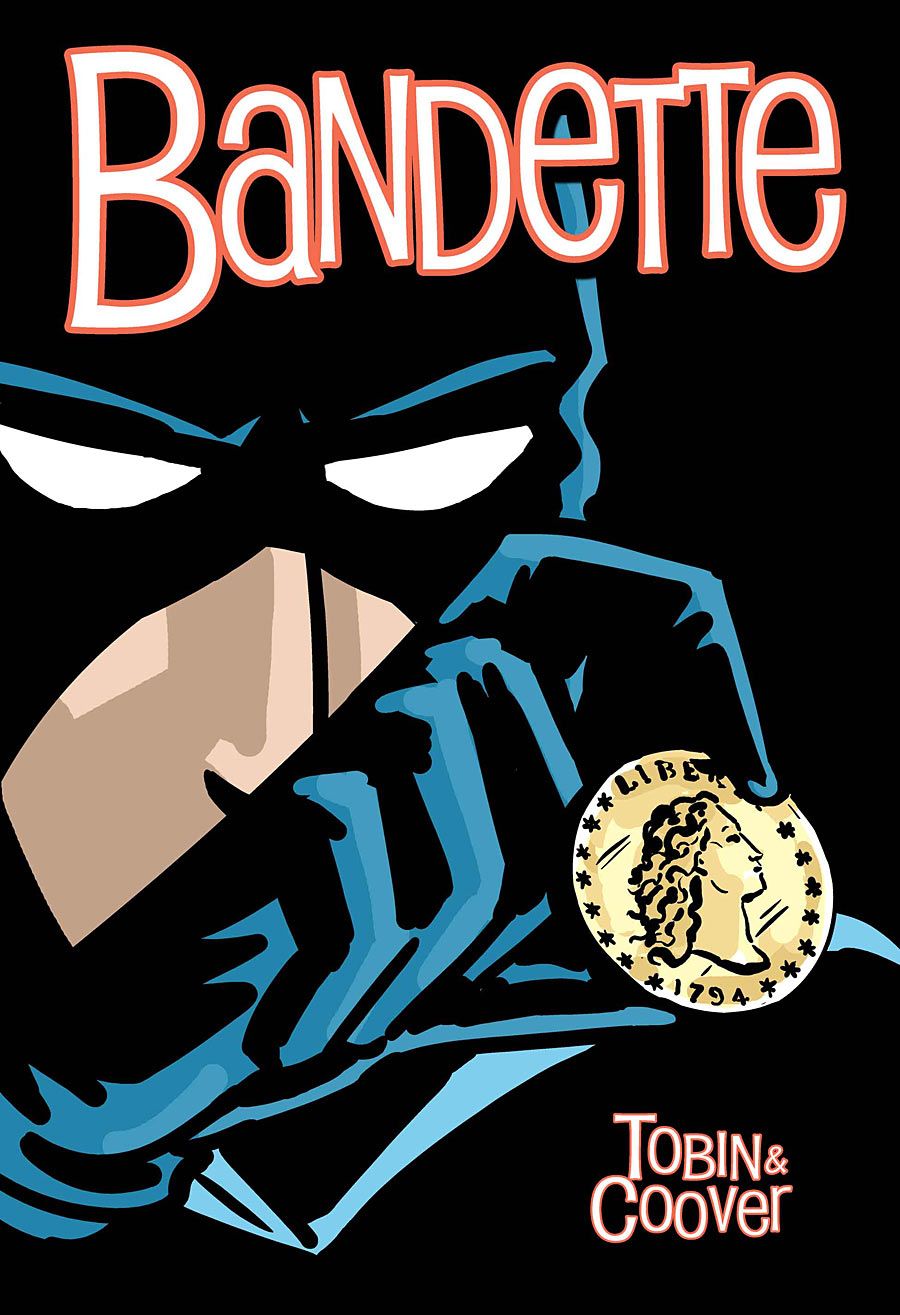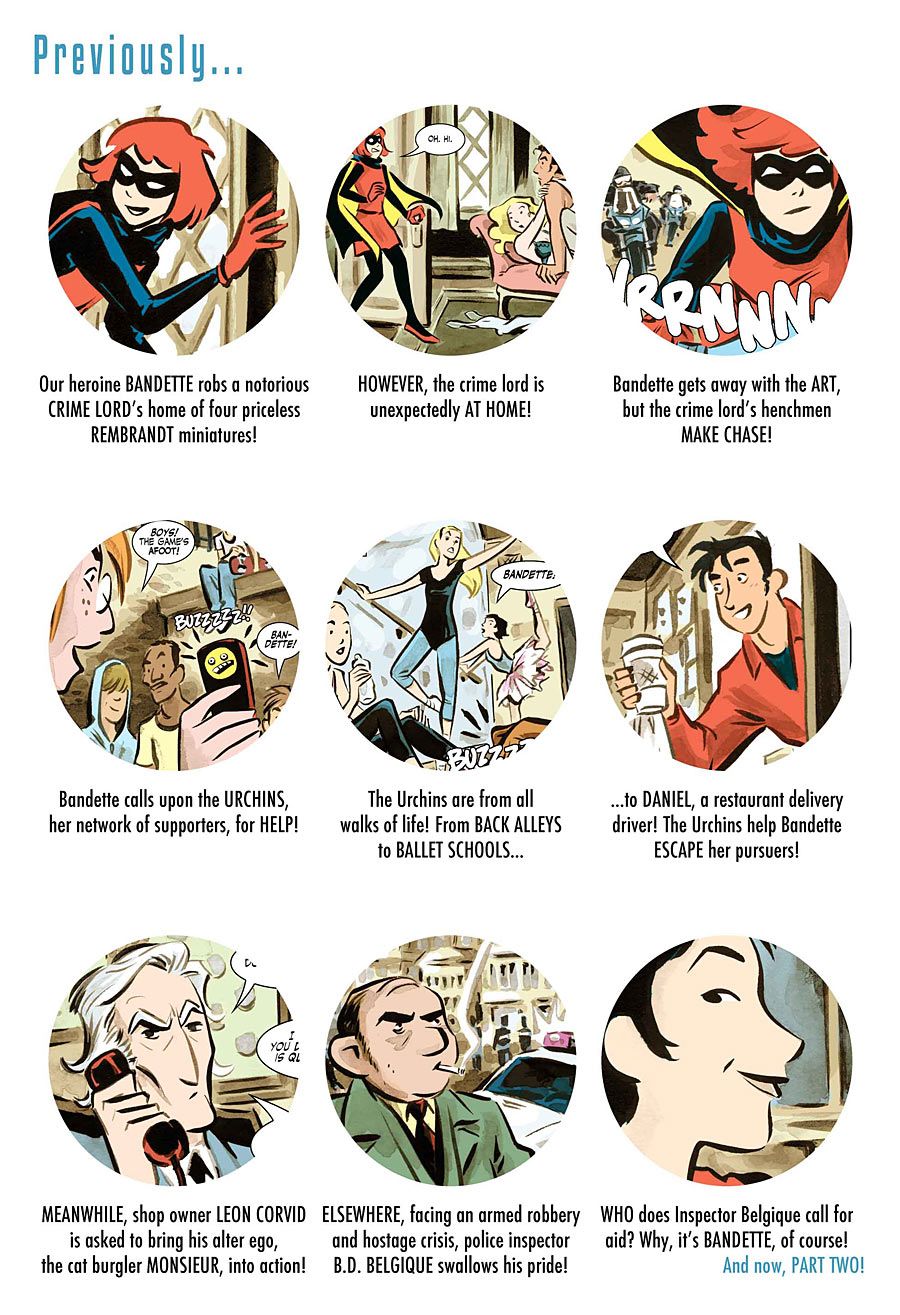One of the clearcut hits from the first wave of Monkeybrain Comics digital line is Paul Tobin and Colleen Coover's Bandette, a great mixture of Tintin and Nancy Drew-type adventure. Today marks the release of Issue 2 -- for the great price of 99 cents -- where (as you can see by the preview CBR ran yesterday) Bandette foils a bank robbery in her own unique way.
To help get people as riled as I am for today's release, I recently barraged Coover and Tobin with a series of questions. As a longtime fan of Tobin's run on Marvel Adventures: Spider-Man, it pleased me immensely that Tobin is building somewhat upon the Blonde Phantom/Chat substories/genre he explored in the former series. I also appreciate a turn of phrase that Tobin used ("zest for life") in discussing the new digital collaboration with Coover. I think zest for life is a quality that fuels Coover's art.
In addition to the digital Issue 2 coming out today, on Saturday Coover will be at the Jet City Comic Show in Seattle. My thanks to Coover and Tobin for their time.
Tim O'Shea: How long had you two been developing Bandette -- well before Monkeybrain as a platform became a possibility?
Paul Tobin: Depends on if we're talking ACTIVELY developing Bandette. In one way, I've been working towards this for a few years. It's where I would have liked to have gone with such things as my Blonde Phantom/Chat substories in Marvel Adventures: Spider-Man ... a sense of adventure and a zest for life, rather than just constant triage, which is what too many superhero comics have fallen into. And I'd been looking at all the material that I like to read or watch ... the Modesty Blaise comics, Tintin, Nancy Drew, Matt Helm movies, that Cary Grant cat burglar movie, and I began thinking, "Why am I not doing material like THAT?" So ... when Monkeybrain asked if Colleen and I would like to do anything with them, I collected all of these thoughts, and out came Bandette. Also, it was partly inspired by a fun sketch of a gruff man with big ears that Colleen put on her blog ... but I'll let her tell that part of the story.
Colleen Coover: Yeah, I had designed “B.D. Belgique of the Sûreté” on a day when I was feeling like drawing a very French character. So when we were discussing what we wanted to do for Monkeybrain, Paul knew he wanted to have a Girl Detective, and I knew that I wanted her to have B.D. as an ally. A lot of the atmosphere for the project comes as much from the character designs as from the script-- for instance, we knew we wanted to have a rival thief/ally for Bandette, so I designed Monsieur based on that idea, and Paul developed his character based on that design.
What interested you in working with the Monkeybrain gang?
Tobin: Chris Roberson and Allison Baker are great friends of ours, so it was partly just natural. But, more than that, one of the reason I love Chris and his work is because our aesthetic matches so well. Look ... if it's akin to Jonny Quest or Challengers of the Unknown or Doc Savage, and it has a gorilla and somebody's brain in a bubble helmet, it's probably either written by Chris or me. Add a hillbilly in there somewhere, and it's probably Jeff Parker.
Coover: And really, when someone comes to you with a business plan and says, “Look, here’s a way for you to do exactly the comics you want to do, with no risk of losing money, we’ll do all the dreary contract negotiating and marketing work and you get 90 percent of net sales and own all rights forever,” there’s no reason not to say yes.
How in the early of the development of the story did you realize you wanted to have her supported by a network of people from all walks of life?
Tobin: Right away. I like the Artful Dodger-type stories, where there's a network of support. And I wanted side characters, interesting people, urchins from everywhere, more pretty girls on mopeds, a vast spider-web of do-good rascals. I admit it was partially inspired by les UX, and their subgroup, the Mexican Consolidated Drilling Authority, both of whose works I find fascinating and lively.
Coover: Yes, the urchins are largely Paul’s inventions, but I enjoy designing their looks! One of my favorite parts of character design is making secondary players who are immediately recognizable, with distinct personalities, just from their physical type. I get to do that a lot with the urchins!
Is there a bit of homage to The Pink Panther with the B.D. Belgique character -- or was the inspiration for B.D. somewhere or someone else?
Tobin: He's inspired by the harried detective type. A bit of Columbo in there as well. I consider him mostly as Colleen's character (which by NO MEANS is me saying I don't love writing him) so I'll let her really dig into this question.
Coover: There is just a smidge of Chief Inspector Dreyfus in Belgique’s character, but B.D. is more of a boots-on-the-ground guy, like Columbo. He’s also broadly inspired by Captain Haddock of Tin Tin, especially in his Gallic temperament!
Can you talk about the coloring on this project--I love how you use it make the lead character pop a little bit more in her scenes?
Tobin: That's all Colleen. I can't even use crayons thanks to childhood trauma and court orders.
Coover: I do my coloring in Photoshop, in several layers. I start with the scans of the inked art, which I set so you can see the colors in the layers below. I then color the image in two layers: on the first layer is all the main figures and objects on the page--the people and things I want to draw the most attention to. The second layer is everything else -- background, secondary characters, and so on. Once everything is colored, I adjust the saturation levels on the background layer down to 40 percent. That tones down the stuff I want to recede, while maintaining a consistent color palette. I should probably do a blog process post with pictures about this with pictures!
Talk about the benefits of setting your story in France?
Tobin: We don't really have a specific "this is where it all takes place!" in our heads. Well, we do ... but it's sort-of-Paris and sort-of-Belgium and so on. It's more a collective world of French comics. Tintin's world. Diabolik's world. It allows us to make Bandette a bit impish, and the streets somewhat more picturesque, and the treasures that much more readily available for light-fingered teen thieves.
Coover: I think of it as a kind of Francophonic, western European version of Ruritania, where everything is familiar, but we have the freedom to do whatever we want in terms of politics, landmarks, and all that. That extends to the setting in terms of time, too. I draw everything in a kind of 1960s Mod style, but there are cell phones everywhere.
While every storyteller hopes and expects their story to resonate with readers, were you taken aback at all at just how widely and well received Bandette has been welcomed by the industry?
Tobin: Not really. I'm more taken aback when my projects aren't lauded with parades. Creators HAVE to be a bit arrogant, and I'm a creator. Of course, that doesn't mean I'm not gratified. And it also doesn't mean there aren't days I'm weeping in my closet, hugging my teddy bear and afraid to face the world, but honestly, I look at Bandette and think, "Who WOULDN'T want to read this?"
Coover: The long and the short of it is: we’re awesome!
What's the biggest advantages to being able to launch a new project digitally?
Tobin: The fact that the material is ALWAYS accessible is huge. If Bandette hadn't been digital, we wouldn't have reached near the audience. The print run would have been small, because a publisher ALWAYS needs to hedge their bets. So, when Bandette came out of the gate so fast and hard, we would have sold out almost immediately. And by the time we had reprints, it would have been too late. With digital, that doesn't matter at all. Moreover, we're going to be doing cool bonus episodes that are as short as two pages. It's very hard to tell a print publisher, "I want to do a comic. It's two pages long. Print that up, would ya'?"
Coover: I really cannot stress enough the fact that digital publishing virtually eliminates financial risk. Anyone who has ever published anything on paper knows that your first consideration is gonna be “how much is this going to cost to print and distribute, and can I afford to lose all that money?” That question can kill creativity right there, because you start to think in terms of what will sell instead of what you want to do. With digital publishing your biggest investment is time.
Can you think of ways you might have approached the story differently if it had been created to go straight to print?
Tobin: Honestly, digital was the only option. Bandette wouldn't exist without Monkeybrain. The economics of it would have precluded the project going forward.
Coover: Agreed. The risk-to-reward ratio would have been too discouraging under any other model I can think of.
What is your other favorite Monkeybrain ongoing that you two are enjoying as much if not maybe more than your own?
Tobin: I'm enjoying Masks & Mobsters and Edison Rex, and there are some others that I'm really excited about, but Bandette is far and away my favorite. Monkeybrain has provided me an opportunity to write exactly the book I want to write, so how can it NOT be my favorite?
Coover: One of the great advantages of teaming up with Monkeybrain, rather than going to comiXology as independent creators, is that Bandette is associated with so many other great comics! I love Wander by Kevin Church and Grace Allison, and some of the upcoming titles have me very excited! (But yes I agree. Bandette RULES!)



